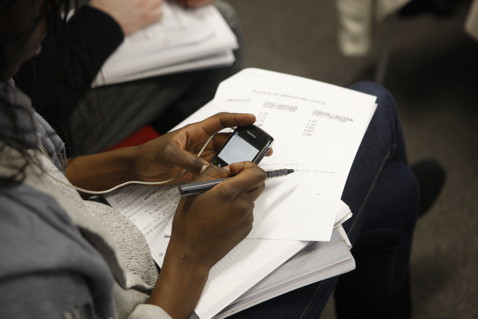Recently, an article by Tosell et al (2014) titled You can lead a horse to water but you can’t make them learn: Smartphone use in higher education has stirred some debate on the topic in email lists and forums in the learning technology world. After giving 24 students iPhones and monitoring their activities using an in-built app and two surveys taken a year apart. The authors found that students felt their iPhones were an unwelcome distraction, contrary to students’ initial belief that smartphones would help in their learning a year later.
The knee-jerk reaction to this finding would be to ban smartphones and devices from the lecture hall and classroom. But with 92% of students reporting to own such a device in our 2013 student survey, that may not be feasible. It’s too late to stop the horse from bolting, and smart devices in lecture theatres and classrooms are here to stay.

92% of students in our 2013 student survey reported owning a smartphone in 2013. Smart devices in the classroom are here to stay. Image copyright: ©2011 LSE/Nigel Stead, all rights reserved.
Banning smart devices from the lecture hall is also not the conclusion Tosell et al come to. The paper itself is a nuanced, well written article, with interesting methods of measurement (albeit with quite a small sample of students without a control group, which the authors do caveat).
What the authors have highlighted, is that providing smart devices to students in an unstructured way and simply expecting students to use these devices for their learning won’t lead to better learning outcomes, and could even be detrimental to learning. This doesn’t seem too surprising, considering Margaryan et al (2011) suggested that even “digital natives” (a contentious term in it’s own right), “…have a limited understanding of how technology may support their learning”. Indeed, White et al (2012) point out that many students gain digital literacy skills, which include using smart devices for learning, through trial and error, without the support of the institution.
Of course, students may not even want to use smartphones for their university work. The authors found that 90% of the apps installed on the iPhones given to students had nothing to do with their courses, and 65% of apps launched were communications or social media apps. Smart devices, smartphones in particular, occupy several important roles in the lives of students, the primary one being the ability to communicate with peers, friends and family. Indeed, a third of students in our own student survey claimed they were uncomfortable with the idea of using their device for university work, highlighting student concerns about managing personal and academic lives in an increasingly connected setting.
Therefore both students and teachers need to evaluate what these devices could bring to them in the classroom. Lecturers could encourage students to use their devices in more positive ways in the classroom, by encouraging the use of smartphones for in-class activities such as voting, fact-checking using the internet, collaboration through social and digital note-taking. Students also need better support and advice from universities on how they could use smartphones and devices for their learning and manage their personal activities.
What’s disputable is that smartphones are simply a distraction, and that students are unable to have a smartphone in class and be able to learn in class. Smartphones and devices are just the latest in a long line of distractions which have diverted students’ attention from the lecture. Ultimately, engaging and accessible teaching and content is what is most likely to stop students from getting distracted in class. What’s more important here is how smartphones and devices could be used in lectures and seminars to engage students better. Tools for engaging students using smart devices already exist, and if harnessed appropriately, smartphones and devices could transform the teaching and learning experience for both lecturers and students, rather than simply be the latest distraction.
References:
Margaryan, A., Littlejohn, A. & Vojt, G. (2011). Are digital natives a myth or reality? University students’ use of digital technologies. Computers and Education, 56, 2, 429–440.
Tossell, A., Kortum, P., Shepard, C., Rahmati, A., Zhong, L. (2014). You can lead a horse to water but you cannot make him learn: Smartphone use in higher education. British Journal of Educational Technology. doi: 10.1111/bjet.12176
White, D., Connaway, L. S., Le Cornu, A., & Hood, E. (2012). Digital Visitors and Residents Progress Report (pp. 0–40). Oxford, Charlotte. Retrieved from http://www.jisc.ac.uk/media/documents/projects/visitorsandresidentsinterim report.pdf






